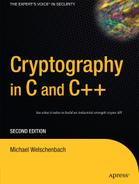Cryptography is an ancient art, well over two thousand years old. The need to keep certain information secret has always existed, and attempts to preserve secrets have therefore existed as well. But it is only in the last thirty years that cryptography has developed into a science that has offered us needed security in our daily lives. Whether we are talking about automated teller machines, cellular telephones, Internet commerce, or computerized ignition locks on automobiles, there is cryptography hidden within. And what is more, none of these applications would work without cryptography!
The history of cryptography over the past thirty years is a unique success story. The most important event was surely the discovery of public key cryptography in the mid 1970s. It was truly a revolution: We know today that things are possible that previously we hadn't even dared to think about. Diffie and Hellman were the first to formulate publicly the vision that secure communication must be able to take place spontaneously. Earlier, it was the case that sender and receiver had first to engage in secret communication to establish a common key. Diffie and Hellman asked, with the naivety of youth, whether one could communicate secretly without sharing a common secret. Their idea was that one could encrypt information without a secret key, that is, one that no one else could know. This idea signaled the birth of public key cryptography. That this vision was more than just wild surmise was shown a few years later with the advent of the RSA algorithm.
Modern cryptography has been made possible through the extraordinarily fruitful collaboration between mathematics and computer science. Mathematics provided the basis for the creation and analysis of algorithms. Without mathematics, and number theory in particular, public key cryptography would be impossible. Mathematics provides the results on the basis of which the algorithms operate.
If the cryptographic algorithms are to be realized, then one needs procedures that enable computation with large integers: The algorithms must not function only in theory; they must perform to real-world specifications. That is the task of computer science.
This book distinguishes itself from all other books on the subject in that it makes clear this relationship between mathematics and computing. I know of no book on cryptography that presents the mathematical basis so thoroughly while providing such extensive practical applications, and all of this in an eminently readable style.
What we have here is a master writing about his subject. He knows the theory, and he presents it clearly. He knows the applications, and he presents a host of procedures for realizing them. He knows much, but he doesn't write like a know-it-all. He presents his arguments clearly, so that the reader obtains a clear understanding. In short, this is a remarkable book.
So best wishes to the author! And above all, best wishes to you, the reader!
Albrecht Beutelspacher
